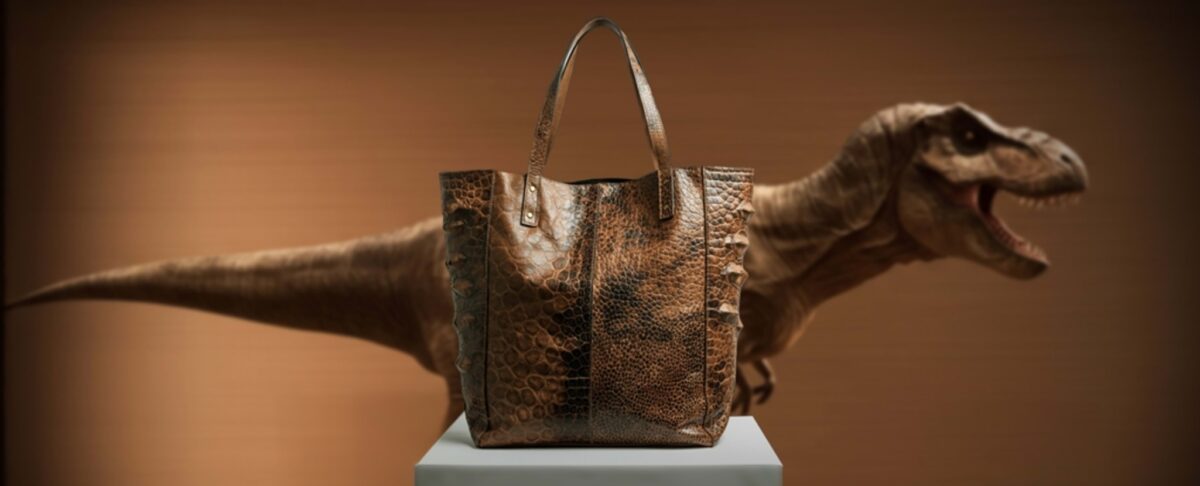
Conceptual image of "dinosaur" leather generated by VML
NEW YORK — You might soon carry a wallet made from dinosaur skin. No, not fossilized—actual leather engineered from T. rex DNA in a lab. In a breakthrough that sounds like science fiction becoming reality, three innovative companies have joined forces to create what they claim will be the world’s first luxury material made from the genetic blueprint of an extinct apex predator.
Creative agency VML, along with genomic engineers at The Organoid Company, and Lab-Grown Leather announced their partnership on April 25. Their ambitious goal? To revolutionize the $780 billion global leather industry by introducing prehistoric biology into the luxury materials market.
“With T-Rex leather we’re harnessing the biology of the past to create the luxury materials of the future,” said Bas Korsten, Global Chief Creative Officer at VML. Korsten is no stranger to headline-grabbing prehistoric innovations, having previously spearheaded the “Mammoth Meatball” project that generated worldwide buzz.
The science behind this innovation uses cutting-edge biotechnology to merge ancient genetics with modern manufacturing. Instead of attempting to clone actual dinosaurs (thankfully avoiding the disasters depicted in “Jurassic Park“), these companies are taking a more focused approach by isolating the genetic information specific to skin tissue.
Scientists start with fossilized T. rex collagen—the primary protein found in skin and connective tissues—which serves as their biological blueprint. The Organoid Company then engineers synthetic DNA based on this ancient template, which gets incorporated into Lab-Grown Leather’s proprietary cell cultivation process known as Elemental-X.
What separates this approach from existing leather alternatives is that these engineered cells grow naturally without artificial supporting structures. Lab-Grown Leather employs what they term a “scaffold-free” methodology, allowing cells to create their own natural structure, resulting in material structurally identical to natural leather. The result is material with authentic leather properties rather than a mere imitation.

But some experts are putting this announcement in the same file as the recent so-called “deextinction” of the dire wolf. Thomas Holtz, Jr., a vertebrate paleontologist at the University of Maryland, told Live Science that the companies’ claims are “misleading” and nothing more than “fantasy.”
Tom Ellis, professor of synthetic genome engineering at Imperial College London, told NBC News that the announcement is a “gimmick,” noting that the collagen produced by the team will likely be no different than other synthetic leathers.
“I doubt that our knowledge of dinosaur evolution is good enough to be able to design a collagen gene specifically from T. Rex,” he said.
Traditional leather production raises multiple ethical and environmental concerns. The industry contributes to deforestation needed for cattle grazing and uses chemical tanning processes involving harmful substances like chromium. These chemicals often lead to water pollution and health risks for tannery workers. The synthetic T. rex leather offers a potential solution to these longstanding problems.
Dinosaurs evolved remarkable adaptations during their 165-million-year reign on Earth. The companies suggest these adaptations make dinosaur-derived materials uniquely suited for today’s challenging conditions. As climate change intensifies, materials inspired by species that thrived during Earth’s most extreme periods could offer superior performance characteristics.

Thomas Mitchell, CEO of The Organoid Company, explained the scientific perspective: “This project is a remarkable example of how we can harness cutting-edge genome and protein engineering to create entirely new materials. By reconstructing and optimizing ancient protein sequences, we can design T. Rex leather, a biomaterial inspired by prehistoric biology, and clone it into a custom-engineered cell line.”
Professor Che Connon of Lab-Grown Leather highlighted the technological achievement: “Our proprietary advanced tissue engineering platform has once again proven its versatility. By collaborating with VML and The Organoid Company, we’re unlocking the potential to engineer leather from prehistoric species, starting with the formidable T-Rex.”
For fashion-forward consumers, the first products made from this prehistoric material should arrive by late 2025, initially focusing on luxury accessories. However, the companies have broader ambitions, with plans to eventually expand into automotive applications and other industries beyond fashion.
For consumers increasingly concerned about both environmental impact and product performance, dinosaur-derived leather offers an intriguing compromise—cutting-edge sustainability with the primal appeal of materials inspired by Earth’s most legendary creatures.







